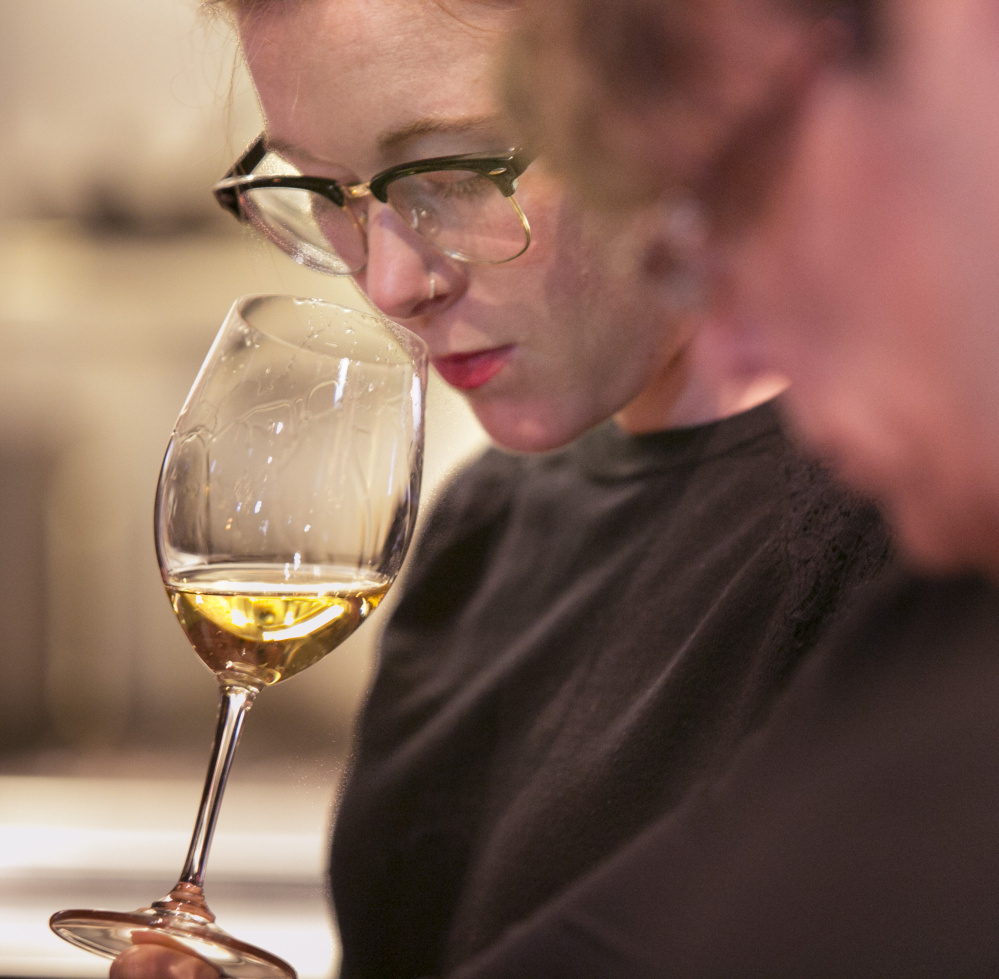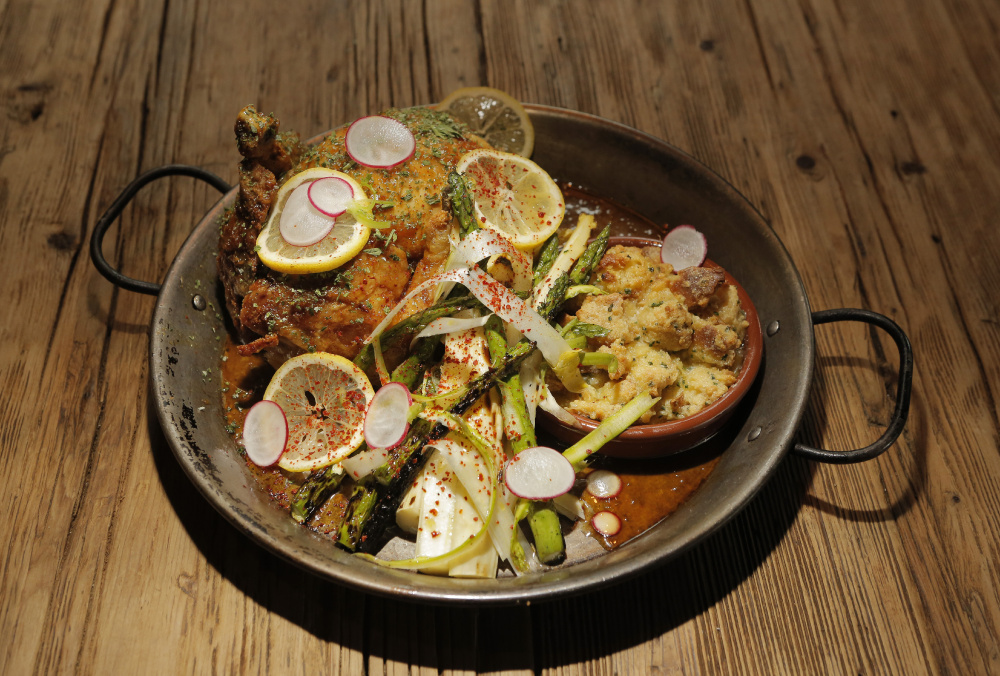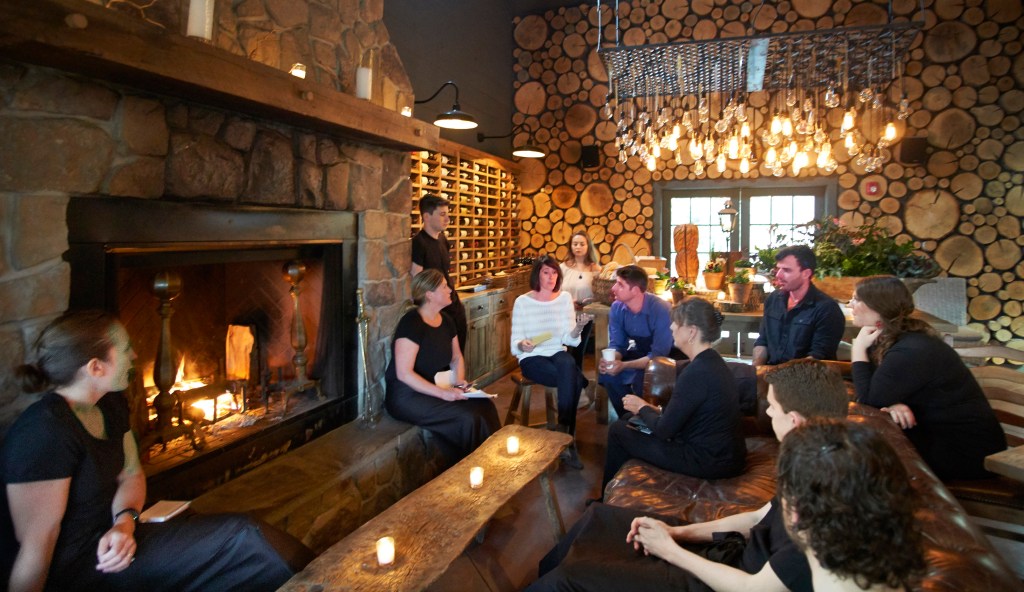KENNEBUNKPORT — It’s the day before Earth at Hidden Pond opens for the season, and general manager Danielle Walker is training seven servers, bartenders and back waiters on the niceties of dealing with summer customers at the high-end restaurant.
If they notice a guest has pushed aside her wine glass, but it still has some liquid in it, how should they determine if it’s OK to remove the glass?
“You just ask, ‘Are you finished?’ Not ‘Are you still working on that?’ ” Walker said to much laughter from her trainees. “Take it up a little bit.”
During an intense training session that lasted several hours, Walker covered topics such as how to show a customer to the restroom (let them go first as you guide them, and open doors for them) and courteous language (say “of course,” “certainly” and “my pleasure,” NOT “no problem,” “no worries,” “yep”or “yeah,” and never call guests “guys” or “folks”).
They practiced pouring wine and setting tables.
“Watching their movements, you can understand who’s cleared a table 50 million times and who hasn’t,” Walker said later.
The summer tourist season is looming, and Maine restaurants are gearing up. That means hiring extra wait staff and training them to deal with all kinds of situations, before their businesses get insanely crowded. It’s a common rite of spring, for both destination restaurants with national reputations and more casual spots that cater to the shorts-and-T-shirts crowd.
Cook’s Lobster & Ale House on Bailey Island opens every year in April with 10 to 12 servers, cooks and bartenders, according to manager Mary Coombs. By Mother’s Day, the number jumps to 25, then to 45 by Memorial Day. Staffing at the peak of summer reaches 70.
Instead of group classes, like those at Earth at Hidden Pond, new staffers at Cook’s shadow experienced employees. On their first shift, they go over management expectations, uniforms, the menu, the logistics of conveying food to tables and their responsibilities when their shifts end. After three job-shadowing shifts, trainees get tables of their own, with a more experienced employee shadowing them to make sure they’re doing everything right. By their fifth shift, they’re on their own.
“You don’t want to just throw somebody out there and be ‘Here you go!’ ” Coombs said.
DiMillo’s on the Water, on Portland’s waterfront, has a large year-round staff, many of whom work more hours in the summer.
“It’s the same people, just working harder,” said Steve DiMillo, co-owner of the restaurant.
Still, DiMillo’s will add about 30 employees to handle the summer swell of tourist traffic. If you’re a student working your way through college, you have to be a local. That’s because students from elsewhere usually have to go back to school in August, when the restaurant is still exceptionally busy.

Earth at Hidden Pond employees sample a chicken dish. As part of the training at the Kennebunkport restaurant, they taste every single item on the menu.
Maureen Lasalle, chair of the Culinary and Hospitality Management programs at Southern Maine Community College in South Portland, said that over the past two months, the school has received three to four inquiries a day from restaurants asking about potential seasonal hires.
“People are starting a lot earlier, especially in your seasonal properties,” she said.
The school encourages its students to snap up these summer jobs in the industry, Lasalle said, and believes they are well-suited for the work.
“From a preparedness standpoint,” she said, “because we’re an associate degree program and we only have them for a short period of time, you try to condense a lot of material quickly. We always focus on what makes a good employee.”
KNOW YOUR OYSTER FORK
At Earth, hiring begins about one month ahead of opening night, which was May 5 this year. Half of the front-of-house staff this season is new, half are returning employees. Even though these are demanding positions, Danielle Walker said, “I love getting people who have no restaurant experience. If they have the radar, if they’re perceptive, you can teach them and they’re not coming with bad habits.”
Katie Cole, 35, of Shapleigh worked as a server for 18 years in Maine and Arizona; this is her third season at Earth.
“It’s a challenging place to work because there’s really a high standard,” she said. “I like that. I like setting goals for myself every season to learn something new.”
Cole went through the early May training, but also helped out by sharing her practical experience with the new seasonal employees as they took turns setting and clearing a table. Place silverware about a foot apart, they were instructed, and about an inch from the edge of the table.
That’s easy enough. But the knives at Earth have handles that are perpendicular to the blade. If they’re not placed correctly on the server’s tray, they will fall on the hard floor, making a noise that reverberates throughout the restaurant. Cole says she learned that the hard way.
Walker reviewed the proper utensils to set out with the seafood paella – an oyster fork for digging out littleneck clams, and a pasta spoon for digging into the rice.
Matt Dyer, the bar manager, demonstrated how to approach customers with wine bottles and place wine glasses on the table. He had one of the trainees sit at a table, taking on the role of a guest, and served a bottle of 2013 Malbec. The label, he noted, should face the guests, and the server’s hands be placed as far down the bottle as possible when pouring.
“Try to keep your elbow out of their face,” he said.
Servers get refresher courses every Thursday at a 3 p.m. wine class that features various regions or varietals.
TALKING POINTS
In addition to learning which plate goes where, staffers at Maine restaurants sometimes have to familiarize themselves with details about the restaurant and its history in anticipation of questions from summer tourists.
At Cook’s, the wait staff must learn about the history of the island and its famous cribstone bridge. They have to know when Cook’s opened and something about the restaurants’ owners.
Restaurant trivia is also on the menu at the staff trainings for Big Tree Hospitality, which owns Hugo’s, Eventide Oyster Co. and The Honeypaw in Portland.
Arlin Smith, co-owner and general manager at Big Tree, said customers at Eventide Oyster ask so many questions about the two blue paint colors on Eventide’s walls that they once named a blue cocktail Forgotten Secret after one of the colors. (The other paint shade is Carthage.)
Customers also often ask about the big granite oyster bar, so servers have to know that the granite came from Phippsburg and was carved in Topsham. The original block weighed 2,500 pounds; after carving, it dropped to 1,500 pounds.

Stephanie Miller, left, and Holly Gillies, waitresses at Earth at Hidden Pond in Kennebunkport, discuss dishes on the menu May 5 before the restaurant’s opening night.
“Having talking points about that allows them to have a better connection to the customer,” Smith said.
Eventide offers its servers regular oyster tastings, so staff – especially those from away – can get up to speed on Maine oysters.
As at Earth, Big Tree trains staff when they come on board for summer, but also offers continuing education throughout the season. And since all three restaurants are open throughout the year, education and training occur year-round.
Every week when managers email the staff their schedules, they include a quiz with three questions that have to be answered by the following week. The restaurants get their coffee from Tandem, so one quiz asked for three facts about Tandem.
Big Tree’s chefs, Mike Wiley and Andrew Smith, won the James Beard Best Chef: Northeast award earlier this month, so that’s likely to send many more tourists their way this summer. But Smith said since they are already busy year-round, he doesn’t expect a big bump in hiring.
YOU CALL THIS WORK?
Summer employees at Earth, like those slurping down Eventide’s oysters, need to become familiar with the chef’s style of cooking. So chef Justin Walker, Danielle’s husband, prepares every single dish on his menu for the staff to taste.
This is just fine with Stephen Fortier, who most recently worked at Central Provisions in Portland. He’s been a server for six years, but this is his first summer at Earth.
“It’s really much easier to give accurate descriptions and also honest opinions when you’ve actually tried the food,” he said.
Dish by dish, the chef brought out food, described it and answered questions. The tasting included chicken wings – brined, poached in beer and tossed in a cascabel chile glaze. A grass-fed New York strip was marinated in dried porcini mushrooms, oyster sauce, dried chiles and peppercorns, then grilled and served with pea gratin.
A whole chicken topped with lemon slices and served with asparagus and biscuit bread pudding came on a huge platter, meant for sharing. As Walker sliced radishes onto the dish, he launched into an incredibly detailed description of how the chicken was prepared:
“Steamed, chilled, and then the backbone out,” Walker said. “Then we coat it in chickpea flour and deep-fry it. It’s glazed with a Meyer lemon honey mustard. It’s Meyer lemon juice and zest and tons of Maille Dijon mustard and honey. And then we add a little bit of chicken stock, reduced chicken jus and butter. We glaze the chicken as it comes out of the fryer, and then it’s sprinkled with dehydrated scallions and fresh lemon.
“The biscuit bread pudding is cultured butter biscuits with local butter. They’re really, really good biscuits. They’re tossed in egg and cream custard and chives. So they’re just biscuits out of the oven, you crumble them a little bit, we add custard, and we bake it every day so it’s fresh, not heavy and dense.”
The group dug into the tender chicken, while Dyer described a “crowd pleaser” white wine that would pair well with it.
Employees are expected to memorize the chef’s food, including sauces, and preparation particulars. Danielle Walker encourages them to spend time in the kitchen, watching the egg whites go into the meatballs and gathering other details.
“If you guys (learn) a dish a day, you’ll be done by Memorial Day,” Walker said. “I guarantee you if you know this menu back and forth, you will do exponentially better.”
Cole, the returning server, said learning the chef’s dishes is “just like studying for a test.”
“You take your notes home and go over them,” she said. “You visualize in your head what that dish looks like, and try to pick out specific flavors.”
After the training, servers are expected to take their theoretical knowledge and put it to work in the dining room. So how did they do? Danielle Walker said she “didn’t see any big potholes” in service on Friday or Saturday night, “which was really encouraging.”
“Both days they did a good job,” she said. “They seem cohesive already, so that’s good.”
Send questions/comments to the editors.











Comments are no longer available on this story